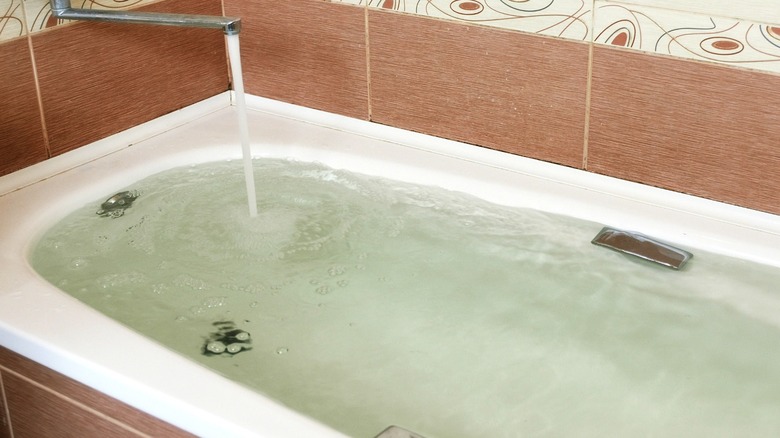How To Snake A Bathtub Overflow Drain
We may receive a commission on purchases made from links.
When you have multiple people sharing a shower, a bathtub-filling clog developing isn't a matter of "if," it's a matter of "when." If you're diligent, you can manage budding blockages, potentially never needing anything more than some unexpected items around the house to unclog your drain. Eventually, though, there'll be a heavy-duty obstruction that no amount of Drano can clear, forcing you to run a drain snake through the overflow, like the Baceyiou 25-Foot Drain Auger.
The overflow is a safety mechanism on the tub wall between the drain and faucet. The metal plate covers a hole leading to the same plumbing line as the drain at the bottom of the tub. Just like the hole at the top of your bathroom sink, this overflow ensures that when the drain is stopped, the tub won't spill over if it continues filling.
In the bathtub's case, the overflow is the proper path for unclogging the drain. The floor drain often has sharp bends that can be harder to navigate and leave a higher potential for damaged plumbing. Plus, the exit point from that drain's immediate run splits in two directions — one toward the P-trap, and the other up toward the overflow. There's a 50/50 chance you'll go up, which wouldn't be helpful at all. Going through the overflow ensures fewer hassles. Remove the overflow plate with a screwdriver and, if your bathtub has a trip lever, pull the linkage assembly from the hole slowly. Now, you're ready to snake the overflow.
Prep the area and start snaking your bathtub overflow drain
For this project, you'll want a standard drum auger. Manual or powered options will work fine, but make sure you don't choose a snake style that's ill-suited to your pipe's size, as this common drain-cleaning mistake could result in scraped and damaged pipes. If your manual auger has a drill connection point at the center of the drum, you can also put your drill around it, using it like a bit to make it a powered snake.
If desired, lay a plastic sheet over the tub's floor. Clearing the drain is dirty work, and this will protect against damage from the auger and give any flung-out debris a place that's easy to clean so that your bathroom stays tidy. You'll also want to wear rubber gloves and keep some paper towels or rags handy to clean the auger and the surrounding area. Extra gear like masks and eyewear may also be necessary, especially if you tried chemical cleaners before snaking the drain.
Locate the locking mechanism on the auger, which may be a lever or screw near the nozzle where the snake exits the drum. When activated, the lock keeps the snake from moving in or out of the nozzle. Unlock it and start feeding the snake into the overflow by hand. Once you hit the P-trap, you'll feel some resistance. At this point, bring the auger close to the overflow so there's about 4–6 inches of exposed cable. Lock the snake, and begin pushing it through the trap.
How to unclog the bathtub drain and finish up
With the lock activated, turn the drum to work the snake through the P-trap bend. Apply gentle but firm pressure as you do this, coaxing the cable into the drain. The cable will slowly enter the hole. Once you run out of slack and the auger drum is against the overflow hole, release more cable, and repeat the process a few more times. When you reach the clog, you'll likely feel its resistance as you turn the cable and break through bound-up hair, soap scum, and debris.
Once you think you've fixed the clog, run water to see if it drains. Unlock the drain snake, and retract it into the drum. Use a rag as you do this to clean the cable since there'll be a decent amount of gunk brought back along the line. After extracting and cleaning the entire snake, run hot water in the tub to flush any debris in the drain and ensure it's emptying quickly.
Finish up by re-assembling the linkage, if applicable, and reattaching the overflow cover. Since you know the drain is flowing freely, now is a great time to check the stopper to ensure that it isn't contributing to a slow-draining line. You may see signs of water damage where water rushed past with every use of the bathtub. After installing it, raise the stopper and see if the water moves as quickly. If not, you might have to remove the assembly, and adjust the screw to raise the stopper.


